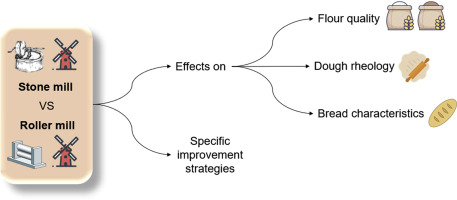Trends in Food Science & Technology ( IF 15.3 ) Pub Date : 2020-01-14 , DOI: 10.1016/j.tifs.2020.01.008 Alessio Cappelli , Noemi Oliva , Enrico Cini

|
Background
Grain milling might be the oldest manufacturing process in the world, and many techniques are currently used in the food industry. The two predominant methods used in wheat milling are stone milling and roller milling. The selected technique significantly influences flour quality, dough rheological properties, and bread characteristics. Choosing the most suitable method is essential; therefore, here we summarise the advantages and disadvantages of each technique and suggest specific improvement strategies.
Scope and approach
The first aim is to summarise current knowledge regarding the effects of stone milling and roller milling on wheat flour quality, dough rheology, and bread characteristics. The second aim is to propose specific strategies to improve the two techniques.
Key Findings and Conclusions
This review highlights the importance of selecting the most suitable technique. Stone milling has a few, clear advantages. These include: ease of use and the simplicity of the system; higher concentrations of macroelements, microelements, and polyphenols in flour; increased whole wheat bread volume; and popularity with consumers. Roller milling, on the other hand, also has advantages. These include: greater efficiency and flexibility; less heat generation; and better dough rheological performance. This review has not declared a “winner”, as both techniques have advantages and disadvantages. The optimal milling system is a function of the aim to be achieved, bearing in mind business needs and product demand.
中文翻译:

碾磨与碾磨:对小麦粉品质,面团流变学和面包特性的影响的系统综述
背景
谷物碾磨可能是世界上最古老的制造工艺,目前食品工业中使用了许多技术。小麦磨中使用的两种主要方法是石磨和辊磨。所选技术会显着影响面粉质量,面团流变特性和面包特性。选择最合适的方法至关重要。因此,在这里我们总结每种技术的优缺点,并提出具体的改进策略。
范围和方法
第一个目的是总结有关石磨和辊磨对小麦粉品质,面团流变学和面包特性的影响的当前知识。第二个目的是提出改进这两种技术的具体策略。
主要发现和结论
这篇评论强调了选择最合适技术的重要性。石材铣削具有一些明显的优势。其中包括:易用性和系统的简单性;面粉中较高的宏观元素,微量元素和多酚浓度;全麦面包量增加;以及在消费者中的受欢迎程度。另一方面,辊磨也具有优点。其中包括:更高的效率和灵活性;发热少;并具有更好的面团流变性能。由于这两种技术都有其优缺点,因此本次评测尚未宣布“赢家”。考虑到业务需求和产品需求,最佳铣削系统取决于要达到的目标。



























 京公网安备 11010802027423号
京公网安备 11010802027423号